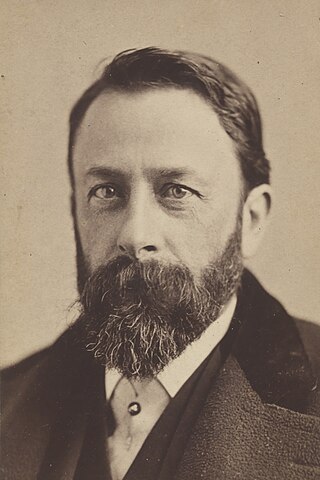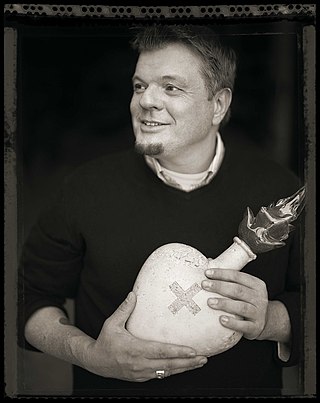Greg Mort (born March 22, 1952) is an American artist and amateur astronomer whose paintings have received numerous exhibitions. His portraits, still lifes and landscape paintings are represented in public collections including the Smithsonian National Air and Space Museum, Corcoran Gallery of Art, Smithsonian American Art Museum, Vatican Observatory, Brandywine River Museum, Farnsworth Art Museum, and the Academy Art Museum in Easton, MD, which was gifted the David H. Hickman Collection of 38 Mort paintings. [1]
Private collections with Mort's work include those of Bill Clinton, Hillary Clinton, Al Gore, Robin Williams and Carl Sagan. [1]
In 2008, the Greg Mort Family established The Art of Stewardship, a not-for-profit foundation to support other artists in expressing their environmental concerns through art. Mort began with his series of Stewardship paintings.
Mort divides his time between the semi-rural village of Ashton, MD and Fieldstone Castle, Port Clyde, Maine. [2]
In 2007, Voyages: Exploring the Art of Greg Mort, written by Greg Mort and edited by Thomas Y. Canby, was published by Sea Glass Publishers. [3] [4]

Jacob Armstead Lawrence was an American painter known for his portrayal of African-American historical subjects and contemporary life. Lawrence referred to his style as "dynamic cubism," an art form popularized in Europe which drew great inspiration from West African and Meso-American art. For his compositions, Lawrence found inspiration in everyday life in Harlem. He brought the African-American experience to life using blacks and browns juxtaposed with vivid colors. He also taught and spent 16 years as a professor at the University of Washington.

Albert Bierstadt was a German American painter best known for his lavish, sweeping landscapes of the American West. He joined several journeys of the Westward Expansion to paint the scenes. He was not the first artist to record the sites, but he was the foremost painter of them for the remainder of the 19th century.

Andrew Newell Wyeth was an American visual artist, primarily a realist painter, working predominantly in a regionalist style. He believed he was also an abstractionist, portraying subjects in a new, meaningful way. The son of N. C. Wyeth and father of Jamie Wyeth, he was one of the best-known U.S. artists of the middle 20th century. James H. Duff explores the art and lives of the three men in An American Vision: Three Generations of Wyeth Art. Raised with an appreciation of nature, Wyeth took walks that fired his imagination. Henry David Thoreau, Robert Frost, and King Vidor's The Big Parade (1925) inspired him intellectually and artistically. Wyeth featured in a documentary The Metaphor in which he discussed Vidor's influence on the creation of his works of art, like Winter 1946 and Portrait of Ralph Kline. Wyeth was also inspired by Winslow Homer and Renaissance artists.

Henry Ossawa Tanner was an American artist who spent much of his career in France. He became the first African-American painter to gain international acclaim. Tanner moved to Paris, France, in 1891 to study at the Académie Julian and gained acclaim in French artistic circles. His painting Daniel in the Lions' Den was accepted into the 1896 Salon, the official art exhibition of the Académie des Beaux-Arts in Paris. Tanner's Resurrection of Lazarus was purchased by the French government after winning the third-place medal at the 1897 Salon. In 1923, the French government elected Tanner chevalier of the Legion of Honor.

Jervis McEntee was an American painter of the Hudson River School. He is a lesser-known figure of the 19th-century American art world, but was a close friend and traveling companion of several of the important Hudson River School artists. Aside from his paintings, McEntee's unpublished journals, written from 1872 to 1890, are an enduring legacy, documenting the life of a New York painter during and after the Gilded Age.
Paul Jenkins was an American abstract expressionist painter.

Raphaelle Peale is considered the first professional American painter of still-life.

Sanford Robinson Gifford was an American landscape painter and a leading member of the second generation of Hudson River School artists. A highly-regarded practitioner of Luminism, his work was noted for its emphasis on light and soft atmospheric effects.

Raphael Zalman Soyer was a Russian-born American painter, draftsman, and printmaker. Soyer was referred to as an American scene painter. He is identified as a Social Realist because of his interest in men and women viewed in contemporary settings which included the streets, subways, salons and artists' studios of New York City. He also wrote several books on his life and art.

The Anchorage Museum is a large art, history, ethnography, ecology and science museum located in a modern building in the heart of Anchorage, Alaska. It is dedicated to studying and exploring the land, peoples, art and history of Alaska.

Elizabeth Murray was an American painter, printmaker and draughtsman. Her works are in many major public collections, including those of the Solomon R. Guggenheim Museum, the Hirshhorn Museum and Sculpture Garden, the Pérez Art Museum Miami, the Museum of Modern Art, the Whitney Museum of American Art, the San Francisco Museum of Modern Art, the Art Institute of Chicago, the Carnegie Museum of Art, and the Wadsworth Atheneum. Murray was known for her use of shaped canvases.
Anne Neely is a painter based in Boston, Massachusetts, and Maine. She paints abstract paintings with an emphasis on landscapes and nature. She uses paint to explore imagined landscapes.

Dan Owen Dailey is an American artist and educator, known for his sculpture. With the support of a team of artists and crafts people, he creates sculptures and functional objects in glass and metal. He has taught at many glass programs and is professor emeritus at the Massachusetts College of Art, where he founded the glass program.

Thomas Chimes (1921–2009) was a painter and artist from Philadelphia. His work is in important public collections, including those of the Philadelphia Museum of Art, Museum of Contemporary Art, Los Angeles, the Museum of Modern Art in New York, the National Gallery of Art in Washington, D.C., The Phillips Collection in Washington, D.C., the Corcoran Gallery in Washington, D.C., the Ringling Museum of Art in Sarasota, FL, the Pennsylvania Academy of Fine Arts, the Wadsworth Atheneum in Hartford, Connecticut, and the Yale University Art Gallery in New Haven, Connecticut, among others.
Joey Foster Ellis is a functional artist and craftsman and a native of Auburn, New York who received his BFA from Central Academy of Fine Arts (CAFA) in 2009, becoming its first American graduate. His work has been exhibited extensively throughout Asia and North America and can be found in numerous private collections including Secretary of State Hillary Clinton and former United States President George W. Bush. He has received several site-specific commissions, including Greenpeace, Bank of America, Chevron and Manulife and his work has been featured in such publications as The New York Times, The Wall Street Journal, Time and Newsweek. Ellis is a recipient of the 2010 TEDGlobal Fellowship and was selected by The Renwick Gallery of the Smithsonian American Art Museum as one of 40 Under 40, a major exhibition highlighting the work of forty artists born since 1972.

Joyce J. Scott is an African-American artist, sculptor, quilter, performance artist, installation artist, print-maker, lecturer and educator. Named a MacArthur Fellow in 2016, and a Smithsonian Visionary Artist in 2019, Scott is best known for her figurative sculptures and jewelry using free form, off-loom beadweaving techniques, similar to a peyote stitch. Each piece is often constructed using thousands of glass seed beads or pony beads, and sometimes other found objects or materials such as glass, quilting and leather. In 2018, she was hailed for working in new medium — a mixture of soil, clay, straw, and cement — for a sculpture meant to disintegrate and return to the earth. Scott is influenced by a variety of diverse cultures, including Native American and African traditions, Mexican, Czech, and Russian beadwork, illustration and comic books, and pop culture.
Patrick Lyons O’Brien is an American artist and writer, known for his children's books and for his maritime paintings. The National Maritime Historical Society awarded O’Brien their Distinguished Service Award for his body of artwork in 2012.

Michael Janis is an American artist currently residing in Washington, DC where he is one of the directors of the Washington Glass School. He is known for his work on glass using the exceptionally difficult sgraffito technique on glass.

Tim Tate is an American artist and the co-founder of the Washington Glass School in the Greater Washington, DC capital area. The school was founded in 2001 and is now the second largest warm glass school in the United States. Tate was diagnosed as HIV positive in 1989 and was told that he had a year left to live. As a result, Tate decided to begin working with glass in order to leave a legacy behind. Over a decade ago, Tate began incorporating video and embedded electronics into his glass sculptures, thus becoming one of the first artists to migrate and integrate the relatively new form of video art into sculptural works. In 2019 he was selected to represent the United States at the sixth edition of the GLASSTRESS exhibition at the Venice Biennale.
Frances Julia Farrand Dodge was an American artist and teacher.